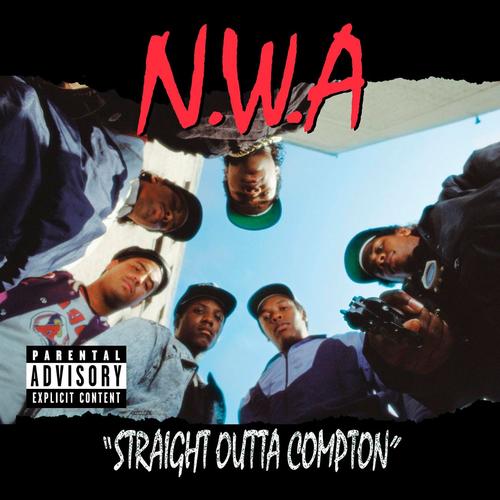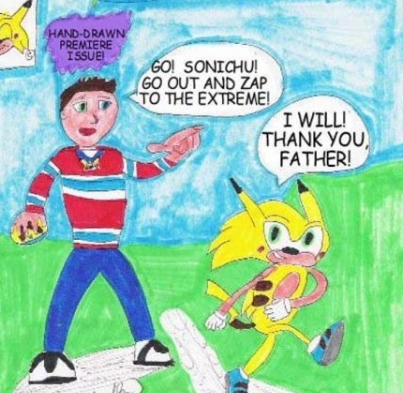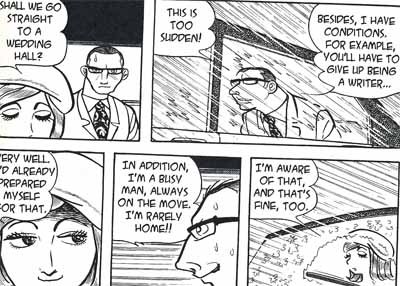 I tried to download this but my computer ran out of niggabytes.
I tried to download this but my computer ran out of niggabytes.
 Sonichu is a comic book character created by internet legend Christian Weston Chandler.
Sonichu is a comic book character created by internet legend Christian Weston Chandler.
This debut issue contains three “Sub-Episodes” (as Chris calls them). First, we see Sonic the Hedgehog accidentally merging himself with a Pikachu, resulting in a badass new Electric Hedgehog Pokemon who zaps lightning and infringes copyrights! Next, we see Sonichu meeting the love of his life, Rosechu. The final part of the saga shows Sonichu saving Rosechu from the clutches of Naitsirhc, Christian’s evil twin.
There’s two avenues of approach to this comic. The first is as a troll or ED user looking for unintentional comedy. There’s actually not much of it here. Obviously, the art and writing are poor, but as far as atrocity tourism goes, Sonichu #0 is pretty weak stuff. There’s no bloody massacres of Chris’s online haters (Sonichu #10), no detailed images of hedgehog penises entering hedgehog vaginas (Sonichu #8), or anything of that sort, really. This comic exists at the “Extra-Mild” section of the spice rack.
The second approach is more rewarding: treat it as a journey into Chris’s mind.
I was like Chris once, drawing shitty freehand comics starring copyrighted characters for no other reason than it made me happy. I was 7 when I did that, and Chris was 23 when he did this, but I can see where he was coming from. Sometimes you’ve got to create. It doesn’t matter if your creation is worthless, or that nobody will ever want to look at it. Some things just won’t let go of you until you put them down on paper.
You can see an honest and earnest attempt here to tell a story, to entertain. There are professional comics out there that don’t give half as much of a shit. I wonder what kind of artist Chris could have been in a different life.
Love him or hate him, Chris brought an interesting flavour to the internet. Granted, it was the flavor of soiled undergarments and Axe, but it was a flavor nevertheless. By the way, I lied earlier. There is one really painful, cringe-inducing moment in Sonichu #0. Chris thought it would be a good idea to include the full text of an email to a real-life girl who snubbed him. Some Chris historian (Christorian?) should track that girl down and talk to her. I’m pretty sure any girl who has met Chris would remember the experience.
No Comments »
 Osamu “Astro Boy, et cetera, et cetera” Tezuka’s 1970 manga is rather weary and cynical. It stars a professional player who thrives because the world full of marks who just can’t wait to get played.
Osamu “Astro Boy, et cetera, et cetera” Tezuka’s 1970 manga is rather weary and cynical. It stars a professional player who thrives because the world full of marks who just can’t wait to get played.
Toshiko Tomura appears to be the ultimate Renaissance woman. At the peak of a successful acting career, she writes a work of literature that achieves national acclaim. Maybe she’s a genius…yet at the same time, there’s something’s not quite right about her. One of her friends has committed suicide. This friend, as it happens, was writing a very similar book to Tomura’s.
A reporter investigates the coincidence, and discovers two things. The first is the trail of destruction Tomura left behind her in her quest to become an actress. The second is Tomura’s wildly dysfunctional upbringing, and the emotional scars that ensure she will never be anything more than an artistic freeloader. She has no identity, no “soul.” She can be anything, and anyone. Yesterday she was an actor, today she’s a writer, tomorrow she’ll be something else. Tomura is like a human insect, metamorphosising from larva to pupa to winged insect…an imperfect metaphor. She is more like an insect that survives by stealing the essence of others.
The Book of Human Insects is fast and accessible. It’s pacing and revolving door of characters reminds me of Tin-Tin. Except if Tin-Tin was this fatalistic, Tin-Tin would have been plugged by Al Capone’s goons three pages in, and Captain Haddock would have died of alcohol poisoning. Tezuka’s classic 70s-style art remains hard to pin down. It shifts from cartoony and funny to erotic and tense and within the same page, and often within the same panel.
Tomura clearly has borderline personality disorder, or something similar, and we cannot wait for her to come to a sticky end. One problem: that moment never comes, at least not in the events covered in this book. Using her wits and physical charms, Tomura is able to outwit and outmanoeuvre an endless gallery of thugs, artists, reporters, politicians, and businessmen, in her journey to become…what? That’s the big unresolved question that makes Tomura’s triumphs seem empty and useless. What is she trying to accomplish? Does she even know?
The Book of Human Insects is another merit badge on Tezuka’s impressive career. All you can say about him is that he was a true storyteller, unconstrained by markets or demographics. He created a Japanese icon in Astro Boy, but there was another, more mature aspect to his work, and books like this are where it is exposed to the full.
No Comments »